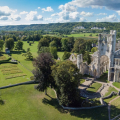Jumièges Abbey, with its 50m-high white towers, offers a virtual walk through its history.
Located on the sloping hillsides of the right bank of the river, in the heart of the Boucles de la Seine nature park, Jumièges Abbey is one of the region’s most beautiful jewels. You’ll first catch a glimpse of its white towers, then enter the park to plunge into its history, intimately linked to that of the river and Northern Europe. The abbey was founded in 654 by Saint Philibert, at the instigation of Saint Ouen, Bishop of Rouen. Its size and impressive number of monks make it the largest and earliest of the Norman abbeys. Its influence was felt throughout the region, until its destruction by the Vikings in 841. Following the signing of the Treaty of Saint-Clair-sur-Epte in 911, which established the Duchy of Normandy, William I initiated its rebirth with a new community of Benedictine monks. But it was after the year 1000 that the abbey truly took on a new dimension. Around 1040, Abbot Robert de Jumièges, known as Champart, began rebuilding the monastery, followed by the construction of the Romanesque Notre-Dame abbey church. In 1204, construction of the choir began, bringing the Gothic style into the whole. In May 1552, Protestants plundered the monastery: altars, holy relics, silverware, furniture, wine, provisions, livestock... everything was destroyed or stolen! A century later, in 1663, the library was rebuilt, the new abbatial dwelling was completed in 1671, followed by the large dormitory in 1732. But the abbey’s grandeur was a distant memory. Finally, the Revolution of 1789 reduced the complex to ruins. The site was used as a stone quarry until 1824. It wasn’t until 1852 that interest in the ruins, which bear witness to flamboyant Norman architecture, took off, thanks to the Lepel-Coitet family, who bought the abbey and set about saving it. The Romantic infatuation with the remains, fuelled by Victor Hugo’s description of the abbey as "one of the most admirable ruins in France", led to the site becoming an object of pilgrimage. Jumièges Abbey became the property of the French state in 1947, then of the Seine-Maritime département in 2007. Among the sculpted stones and lapidary works on display in the abbey’s logis abbatial are the tomb of the Enervés de Jumièges, the head of William the Conqueror and the tombstone of Agnès Sorel. For fans of technology, the "Jumièges 3D" application lets you virtually walk through the 16th and 18th centuries using a tablet or smartphone.
Did you know? This review was written by our professional authors.
The strengths of this establishment:
Book the Best Activities with Get Your Guide
Members' reviews on TWIN ABBEY
The ratings and reviews below reflect the subjective opinions of members and not the opinion of The Little Witty.
Find unique Stay Offers with our Partners




